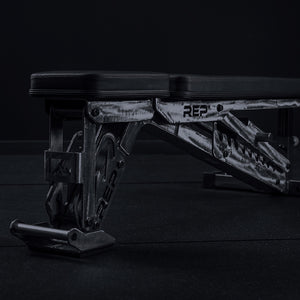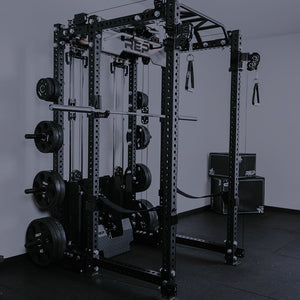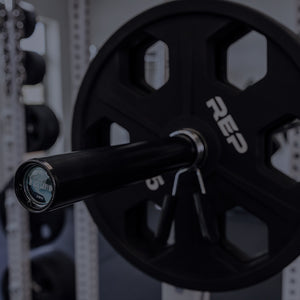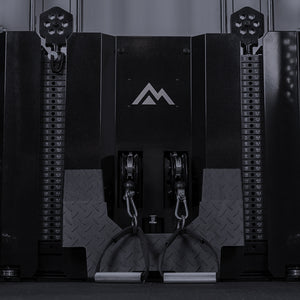
They check all the boxes: They’re versatile, compact, lightweight, inexpensive, and accessible to all levels. Exercise bands can be a key part in a quality home gym.
And while they’re easy to use, that first requires knowing what’s what -- about the different types of workout bands and their unique purposes. You don’t want to be doing band pull-aparts with a floss band or trying to do banded deadlifts with a hip circle; that would be an Armageddon-level disaster. If you could somehow pull it off. (Please don’t take that as a challenge to try unless you are literally Jujimufu. The rules don’t apply to him.)
What are Workout Bands?
Exercise bands are stretchy, portable tools that add resistance to your workouts without the need for heavy weights. They’re basically giant rubber bands for grown-ups — perfect for strength training, stretching, and leveling up your fitness anywhere.
Don't mistake them for straps. Exercise straps are typically non-elastic and used to assist with stretching and stability, while exercise bands are elastic and provide resistance to build strength and flexibility.
Do Resistance Bands Build Muscle?
Heck yes, resistance bands can build muscle! They might look like oversized rubber bands you found in the kitchen drawer, but don’t let their simplicity fool you. When used correctly, resistance bands create the same kind of tension your muscles need to grow — just like free weights or machines. The key to muscle-building (no matter the tool) is resistance, and bands deliver it in a smooth, joint-friendly way that's easy on your body but tough on your muscles.
Science says so, too. Research shows that training with resistance bands can increase muscle strength and size comparably to traditional weight training. Bands create what's called variable resistance — meaning the resistance increases as the band stretches — which challenges your muscles through a full range of motion and keeps them guessing (and growing). Plus, bands fire up your stabilizer muscles more than some machines do, giving you extra hidden benefits along the way.
So yes, if you’re chasing gains, don’t sleep on bands. Whether you're a beginner building your foundation or a seasoned lifter looking to add extra intensity (hello, banded deadlifts and push-ups), these stretchy superheros absolutely deserve a spot in your training routine. Spoiler alert: Your muscles don't care if it's a barbell or a band; they just care that you're working hard.
Here’s a closer look at REP’s four different kinds of fitness bands and how to use them.
Pull-Up Bands

What are they? Stretchy, 38” long loops made from layered elastic. There are no handles. Width varies by size; the lighter-resistance band is thinner and the heavier-resistance band is wider.
Different options: Pull-Up Bands come in seven sizes with varying widths and colors. Bands start with XXX-Light (yellow), with a 0.25” thickness and 5-15lbs resistance, and they top out at X-Heavy (orange), which is 3.25” thick and creates 70-175lbs of resistance.
How to use them: As the name suggests, a popular usage is to assist with pull-ups. If you can’t do an unassisted pull-up, they can make it easier. And if you can, they can allow for higher volume. But that’s far from the extent of their uses.
You can attach resistance bands to band pegs on your power rack to create added or different resistance while weight training. This is especially helpful when training compound lifts. For example, attach the bands low and loop them around the ends of the barbell to help train your deadlift lockout by making the top portion of the lift the most difficult.
You can also get in a full-body strength-training workout with just resistance bands: chest presses, squats, curls, rows, you name it. And no, that’s not just an empty promise. A study published in the National Center for Biotechnology Information found that resistance bands had a similar effect on strength gains as regular gym equipment. Now, that’s likely not going to hold true for more experienced lifters and competitors, but for a new or average lifter, the important take-away is you can get in a good workout with bands.
The size variations of the Pull-Up bands are designed for different levels of fitness and purposes.
You can also use resistance bands for stretching. Stretching with bands is an easy and effective way to improve flexibility, mobility, and range of motion. By using a resistance band for assistance, you can deepen your stretches, maintain better form, and control the intensity. Whether you’re targeting your hamstrings, shoulders, or hips, stretching with bands helps you ease into positions and hold them longer, making it a great tool for warming up before a workout or cooling down afterward.
Short Resistance Bands
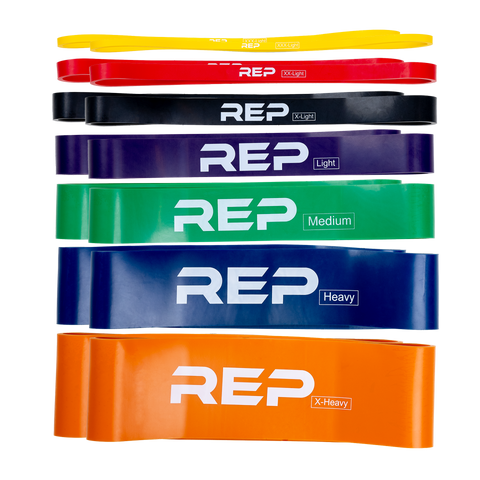
What are they? A shorter, 12” version of the standard 38” long Pull-Up Bands.
Different options: They come in seven sizes of varying resistance, width, and colors. Bands start with XXX-Light (yellow) with a 0.25” width and 5-15lbs resistance, and they top out at X-Heavy (orange), which is 3.25” wide and creates 85-230lbs of resistance.
How to use them: The size variations are designed for different levels of strength and purposes, such as training for a pull-up or providing an extra challenge on compound lifts. To add resistance while weight training, attach the bands to a cable machine or power rack with band pegs and then loop the bands around your barbell.
You can also use bands for accessory work, stretching, rehab, and warming up.The shorter length makes it easier to set them up and eliminates the need to double or triple up the band over pins or band pegs to get enough tension for banded lifts.
Tube Resistance Bands with Handles

What are they? Lightweight, portable bands featuring handles on either end. The handles give you something to hold onto while working out. These are not loops. They are all about 49" long (about 4').
Different options? These bands are offered in three different color-coded options, so you can quickly identify the difficulty levels. The blue band (9mm) is light resistance; the orange band (12mm) is medium; and the black band (13.5mm thick) is the heaviest resistance.
How to use them? Use the Tube Resistance Bands for strength training, stretching, physical therapy, rehab, and more. Because they aren’t a loop, these aren’t optimal for pull-up assistance or adding challenge to compound lifts.
But due to the easy-to-grip handles, these are ideal for resistance band workouts. The handles are more comfortable and easier to hold onto than just gripping the elastic on the Pull-Up Band. They also allow your hands to be in a more natural position than a loop-style band.
Circle Hip Bands

What are they? Shorter, wider, stretchy loops lined with grip strips on the inside of each band to prevent slipping and folding. They’re made from a thick polyester fabric, whereas the looped bands are only elastic. Circle Hip Bands are compact, at 3.2”(W)x12.5”(L). They’re much shorter than the other exercise bands.
Different options? These bands are available in three different resistance options and are color coded and labeled for easy identification. Light resistance is red, medium is black, and blue is heavy
How to use them? Circle Hip Bands can help you warm up, strengthen muscles, add resistance to lifts, and improve mobility and recovery. Per the name, these are especially designed for hip/glute/leg exercises.
Their shorter width fits around most people’s upper thighs (above the knees) to add resistance for exercises like squats, clams, lunges, “fire hydrants,” glute bridges, donkey kicks, glute kickbacks, leg lifts, monster walks, lateral band walks – all the leg day fun. The goal is to keep pushing outward when the band is trying to pull your knees inward.
Hip bands can also require some core engagement. Some lifters add them into weighted exercises (like leg press) for added challenge, too. Add resistance during squats, deadlifts, push-ups, and chest presses. Improve stabilization and mobility, as well.
Short Loop Bands
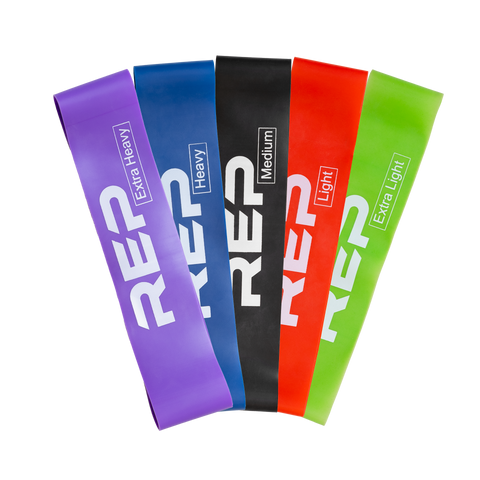
What are they? Latex or latex-free looped bands that are 9" long, 2" wide, and can stretch up to 2.5 times in length. While the Circle Hip Bands are also short loops, these are stretchier, not as wide, and made from a different material.
Different options: Five different resistance levels: extra light, light, medium, heavy, and extra heavy. They are sold as a set.
How to use them: This type of band is ideal for shorter, more targeted exercises. Use them to help you warm-up, strengthen muscles, improve mobility and recovery, and perform rehab work. You can also use these for similar exercises as the Circle Hip Bands, but they feel different and don't provide as much resistance.
Floss Bands

What are they? Long (7’), flexible bands designed to wrap around a muscle or joint to help with recovery and blood flow. These have no handles and are not a loop.
Different options? Floss Bands come in two sizes. The thicker red band (0.06”) is ideal for larger muscle groups and joints, while the thinner black band (0.05”) is better for smaller muscles and joints. Both bands are 7’ long and 2” wide.
How to use them? These aren’t for creating resistance, and they’re definitely not meant to assist your pull-ups. Floss Bands are designed to improve your mobility, blood flow, and recovery. Wrap a muscle or joint with a band, perform range-of-motion exercises for up to two minutes, and then remove the Floss Band. They can help with recovery in areas that foam rollers and lacrosse balls can’t reach.
By tightly wrapping the muscle and working the joint through a full range of motion for a couple of minutes, the friction between muscle fibers will help break up lactic acid, scar tissue, and other “junk” in the area. Upon removing the band, blood flows back to the targeted muscles, clearing out the area and bringing essential nutrients for healing. Use Floss Bands on your shoulders, arms, elbows, wrists, knees, hamstrings, calves, ankles, and feet.
Can Resistance Bands Cause Neck Pain?
Resistance bands are one of the best tools you can have in your fitness toolbox. But like any piece of equipment, using them with sloppy form can lead to problems, including neck pain. It’s not the band’s fault; it’s all about how you use them.
Most of the time, neck pain from resistance bands comes from poor technique — things like yanking the band, choosing one that's too heavy, or letting your shoulders creep up toward your ears. When your form slips, your body tries to compensate, and your neck muscles might take on work they weren't built for. Studies back this up: Faulty movement patterns and muscle imbalances are major causes of neck strain during resistance exercises.
The fix?
- Keep your shoulders relaxed and away from your ears
- Use smooth, controlled movements
- And pick a band that matches your current strength level (there’s no gold medal for choosing the thickest band too soon).
Resistance bands are meant to make you stronger, more mobile, and more awesome — not to send you to the massage table. Nail your form, and these bands will be one of the smartest, most body-friendly tools you can use.
Aimee Heckel, CPT, is a health and fitness journalist with over 20 years of experience. She set an all-time world-record deadlift in her division across all powerlifting federations at Mr. Olympia. In addition, she earned a national deadlift record and 18 Colorado state records. Heckel also has nine world records in grip sport, a pro card in natural figure bodybuilding, four first-place bodybuilding titles, and was named IPE Ms. Colorado Figure.

NEWSLETTER SIGNUP
Product launch information, promotions, blogs, and REP news.

